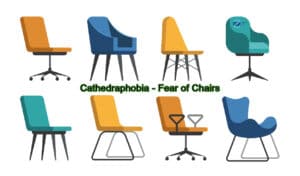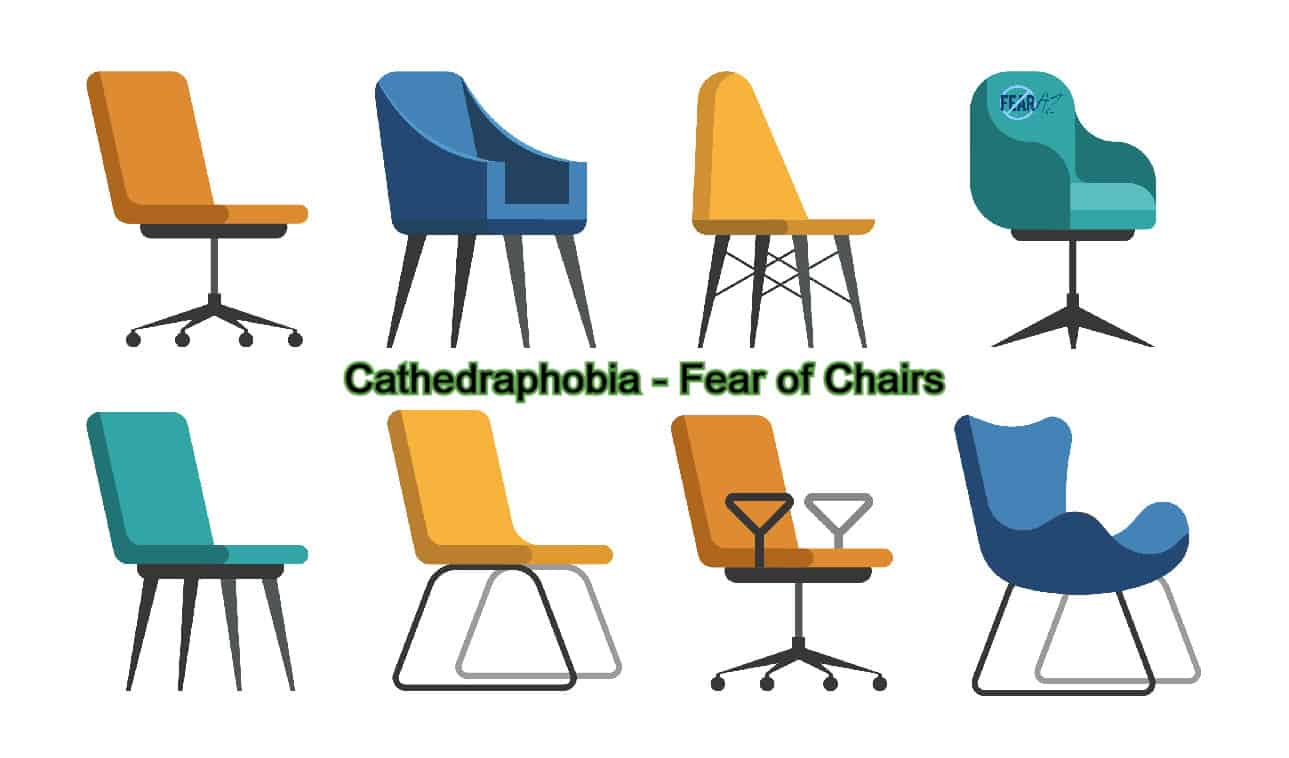Share This Article
Cathedraphobia, A Rare but Real Phobia
Are you afraid of sitting in a rocking chair? Do you get nervous at the sight of an office chair?
Do you prefer standing for hours rather than sitting comfortably in a chair?
Does the sight of a chair make your heart race and your body tremble?
Does your issue come from the fear of falling from a chair or something similar? Why do you have this rare phobia? Let’s try to uncover the underlying issues.
This may seem like an illogical fear, but if your answers to the above questions were yes, then you might have cathedraphobia, the fear of chairs. Cathedraphobia is very limiting because you are bound to find chairs wherever you go.
Explaining why you avoid going out with friends and family must be difficult for you. But don’t worry, there are many different kinds of phobias, and people are increasingly aware of mental health issues.
Also, fortunately, there is hope for people with chair phobia, and it is treatable. With dedication and consistency, you can learn to overcome your phobia by using self-help techniques. Additionally, there are professionals ready to help you on your route to a phobia-free life.
What Is Cathedraphobia
Cathedra is a Latin word meaning chair or seat, and phobia is a Greek word meaning fear. Cathedraphobia is a chair or seat fear.
Because of today’s stressful and competitive lifestyle, many people have mental health issues, and newer cases of phobias are being recognized.
Cathederaphobia is one such phobia. It is less common, but people with the phobia suffer from chair aversion or chair anxiety.
Chair anxiety is a specific phobia and is considered a branch of epiplaphobia, the fear of furniture.
One may be averse to all types of chairs or only particular ones. For example, some may avoid office chairs because they worry they’ll be impaled by the spindle or post. Others may fear rocking chairs, afraid that it will flip over.
Some may even be afraid of antique chairs—something once used by dead people. Those with the phobia often restrict themselves to chairless homes altogether.
Whatever the case, the person suffering from the phobia avoids the object of their fear, leaving the room if they spot a chair. This drastically affects their personal life, education, and professional life. The person may find it difficult to sit in a class facing the teacher’s chair or even in the office. They may discontinue their education and take jobs where they do not have to worry about spotting a chair.

Causes of Cathedraphobia
The exact cause of any phobia cannot be determined. However, it’s often a combination of factors that results in a person developing chair-related panic.
It could be a traumatic childhood experience when a child tipped over and fell, or perhaps an abusive parent used to throw chairs during a fight. It could also be that, as a child, the person experienced chairs crashing around the room during a storm.
The phobia could also stem from something imprinted in memory, where one has associated chairs with the bad omen of a fierce storm.
People with a familial history of mental health issues or who have a mental health condition can also develop phobia. For such people, triggers such as seeing someone else exhibit fear of the chair can lead to the development of phobia.
Being in an abusive family or having a stressful life can also put a person at risk of developing a phobia.
Symptoms of Cathedraphobia
Cathedraphobia is a specific phobia that shares symptoms with other specific phobias and anxiety disorders. In this phobia, the most prevalent symptom is avoidance behavior. The person avoids places where they can spot a chair, which ultimately results in them restricting themselves to the four walls of their homes.
Other symptoms may include:
Physical Symptoms
- Sweating
- Palpitations
- Increased heartbeat
- Trembling
- Nausea
- Headache or dizziness
- Sweaty palms
- Shortness of breath
- Gastric distress
- Tightness of chest
Mental/Emotional Symptoms
- Anxiety
- Panic attack
- Strong desire to flee
- Irrational thoughts swirling in the mind
- Irritability
- Anger
- Feeling of hopelessness
- Sadness
- Guilt
- Shame
Treatment of Cathedraphobia
There is no defined treatment for many specific phobias, however, treatment is mostly generalized and works for all specific phobias. Treatment options include therapies that help the patient clear their mind, develop more accurate beliefs, and achieve tranquility.
It is thought that mental health issues often result from inner turmoil. Treatment based on this approach has good results. Additionally, you can use this approach as a self-care technique.
The most common treatment approaches for cathedraphobia are:
Self-Help
Self-help starts with recognizing the issue and accepting it. Many patients resort to avoidance behaviors and do not accept the fact that something is amiss and needs to be fixed. This is partly due to the taboo surrounding mental health, and partly due to personal choices.
If you feel you don’t want to share your phobia with anyone, that’s fine. However, you can try these self-help techniques, which will help calm your mind and help you cope with your anxiety.
- Yoga
- Meditation
- Exercise
- Breathing techniques
- Relaxation techniques
You must practice these techniques regularly and with the right mindset. Additionally, if you find yourself in the middle of a panic attack, you can try to divert your attention by trying to:
- Count numbers
- Spot objects
- Practice deep breathing
You can also start journaling, as it is found to be useful for patients with mental health as well as other medical issues.
Professional Help
In most cases, self-help is sufficient. However, if you find your symptoms to be persistent or increasing, you can reach out to a health professional.
A psychiatrist or therapist is an expert in the field with the necessary knowledge and experience to recommend the best treatment plan for you.
For specific phobias like cathedrophobia, most doctors use therapies such as:
- Cognitive behavioral therapy (CBT)
- Systematic desensitization
- Exposure therapy
In rare cases when the symptoms are severe, your doctor may prescribe medication. These are often beta-blockers or antidepressants. They are only meant to reduce the symptoms temporarily and do not have any role in overcoming the phobia.
Coping with Cathederophobia
Living with cathederophobia is no laughing matter. Even the thought of going out and spotting a chair terrifies people with the phobia. They may avoid the outdoors at all costs, even if it means sabotaging their relationships.
However, there is hope. A positive approach, active work, and seeking treatment will help you recover quickly.
Conclusion
Cathederophobia is a phobia of chairs. A trigger such as a chair—something that is found everywhere—is hard to avoid. However, taking initiative and keeping your mind open to treating it will help you overcome your phobia.



